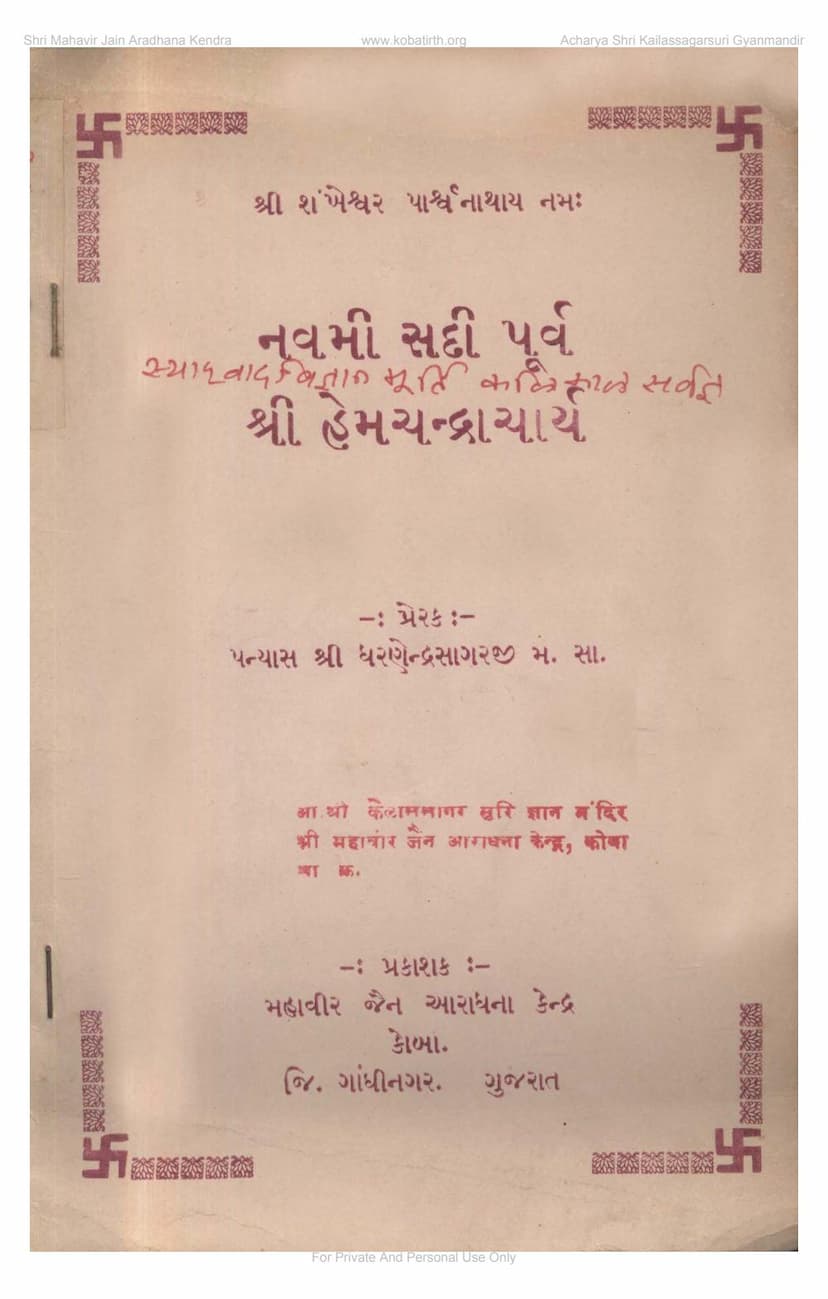Navmi Sadi Purva Hemchandracharya
Added to library: September 2, 2025

Summary
This document is a collection of devotional hymns and biographical information about Acharya Hemachandra, a prominent Jain scholar and saint who lived in the 11th and 12th centuries CE. The book is titled "Navmi Sadi Purva Hemchandracharya" (meaning "Acharya Hemachandra of the Ninth Century Before [our current era]") and is authored by Dharnendrasagar. It is published by Mahavir Jain Aradhana Kendra Koba.
Here's a comprehensive summary of the content presented across the provided pages:
Overall Theme: The collection is a tribute to Acharya Hemachandra, highlighting his immense contributions to Jainism, literature, grammar, and social reform, particularly during his patronage of King Kumarpal. The devotional songs (Sajhayan, Gadhuli, Stuti) praise his virtues, wisdom, and impact.
Key Information and Content:
-
Publisher and Author: The book is from the Shri Mahavir Jain Aradhana Kendra in Koba, Gujarat, and is inspired by Panyas Shri Dharanendrasagarji.
-
Devotional Songs (Sajhayan, Gadhuli, Stuti):
- Page 2: Presents "Hemchandracharya Ashtakam" (Eight Verses on Hemachandra) composed by Shri Muni Mukti Vimalji. These verses laud Hemachandra's wisdom, detachment, purity, and ability to dispel ignorance.
- Page 3: Contains a "Sajhayan" (devotional song) on Acharya Hemachandra in the "Kalyan" raga, praising him as a Kalpa-taru (wish-fulfilling tree) of Kali Yuga, a great giver, and a gem of knowledge.
- Page 4-5: Continues the "Sajhayan" in a different raga, addressing Hemachandra as "Hemchandra Bhagwan" and seeking his solace and guidance in the current era of decline (Pancham Kaal). It recounts his birth, renunciation, and his role in guiding King Kumarpal.
- Page 6: Features a "Stuti" (hymn) to Acharya Hemachandra, calling him "Kallikal Sarvajna" (Omniscient of the Kali Yuga), composed by Punjab Kesari Vijay Vallabhsurishwarji. It highlights his role in promoting righteousness, compassion, and justice, particularly his influence on King Kumarpal and his efforts to prevent animal sacrifice.
- Page 7-9: Presents a "Gadhuli" (a type of devotional song) on Acharya Hemachandrasurishwarji by Muni Shri Kapoor Vijayji. It narrates his birth in Dhandhuka, his initiation, his deep asceticism, his attainment of the Acharya title, his role in converting King Kumarpal to Jainism, and his prolific literary output, including works known in Europe. It also mentions his passing.
- Page 10: Includes another "Gadhuli" on Acharya Hemachandrasurishwarji by Shri Buddhisagar Surishwarji. It reiterates his omniscience, his status as a chief disciple of Lord Mahavir, his role in spreading compassion across India, and his significant contributions to grammar (Siddha Hem) and philosophy.
- Page 11-12: Presents a "Stuti" on Acharya Hemachandra by Panyas Samudravijayji. It details his birth in Dhandhuka, his early initiation by Devachandrasuri, his scholarly prowess, his influence on King Kumarpal to promote Jainism, and his vast literary achievements. It also mentions his disciples and his reverence for his gurus.
- Page 13: A devotional piece in Urdu/Persian script lamenting the loss of the guru, emphasizing Hemasuri's role as a guiding star and the creator of impactful literature that dispelled ignorance. It also touches upon his influence on King Kumarpal and his protection from external threats.
- Page 18: Contains verses from the famous Bhaktamar Stotra, attributed to Acharya Manatunga, which are universally revered in Jainism. These verses are likely included to contextualize the devotional practices associated with great Jain Acharyas.
-
Biographical Details (Jivan Jharamar):
- Page 14: Provides a concise biography of Acharya Hemachandra, referred to as "Jivan Jharamar" (Life's Flow). It includes:
- Birth Year: Samvat 1145 (1088 CE)
- Birthplace: Dhandhuka (Gujarat)
- Birth Name: Changdev
- Caste: Madh Vanik (merchant)
- Father: Chachinga
- Mother: Pahini (Chahini) Devi
- Initiation Year: Samvat 1150 (at age 5)
- Initiation Name: Hemachandra
- Initiation Guru: Devachandrasuri
- Rachha Name: Purnatal Gachha
- Acharya Title Year: Samvat 1166
- Associated Kings: Siddharaj, Kumarpal
- Demise Year: Samvat 1229 (1173 CE)
- Place of Demise: Anhilpur Patan
- Successor Disciple: Ramachandrasuri
- Major Work: Siddha-Hema-Shabdānushāsanam
- Page 14: Provides a concise biography of Acharya Hemachandra, referred to as "Jivan Jharamar" (Life's Flow). It includes:
-
Literary Works:
- Page 15: Lists Acharya Hemachandra's extensive literary creations, categorized as "Sahitya Krutiyon" (Literary Works). This includes renowned works like:
- Siddha-Hema-Shabdānushāsanam (with commentary)
- Kavyānushāsanam
- Chhandānushāsanam
- Alankārānushāsanam
- Vāḍānushāsanam
- Dhatu Parayan
- Mahārnava Nyas
- Trishashti Shalaka Purusha Charitra (a monumental work detailing the lives of 63 illustrious persons)
- Anyoga Vyavachheda Katrishika
- Dvarishika
- Abhidhan Chintamani (with commentary)
- Parishishta Parva
- Ahanniti Saptasandhan Mahakavyam
- Dviashraya Mahakavya (Sanskrit)
- Kshiradhimaka (Prakrit)
- Vitaraga Stotra
- Mahadeva Stotra
- Ahannama Sahasra Samuchchaya
- Pramana Mimansa
- Yoga Shastra (with commentary)
- Deshiya Namamala
- Page 15: Lists Acharya Hemachandra's extensive literary creations, categorized as "Sahitya Krutiyon" (Literary Works). This includes renowned works like:
-
Disciples:
- Page 16: Lists some of Acharya Hemachandra's prominent disciples (Shishyaratna), including Mahendrasuri, Ramachandrasuri, Gunachandragani, Vachanganigani, Devachandramuni, Yashashchandragani, Udayachandri, and Khadachandri.
In essence, the book "Navmi Sadi Purva Hemchandracharya" is a devotional compilation celebrating the life and legacy of a pivotal figure in Jain history. It uses traditional devotional songs and biographical data to underscore his profound influence as a scholar, spiritual leader, and social reformer. The content emphasizes his omniscient nature, his role in shaping King Kumarpal's reign through the promotion of Jain principles, and his unparalleled contribution to Sanskrit and Prakrit literature.